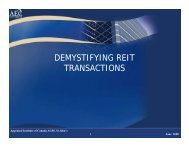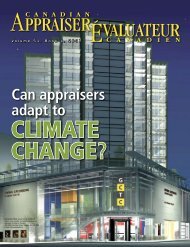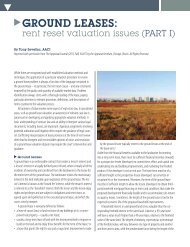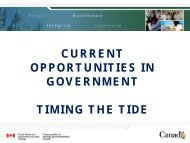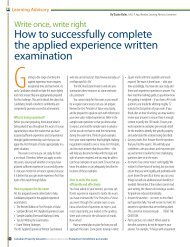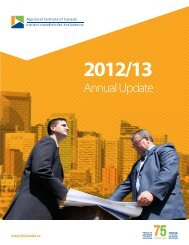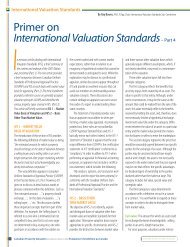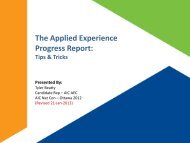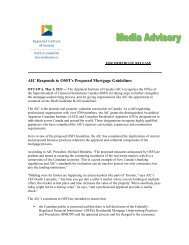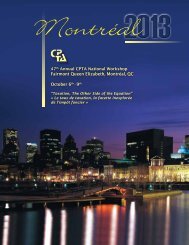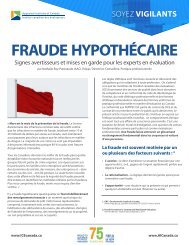Book 2 - Appraisal Institute of Canada
Book 2 - Appraisal Institute of Canada
Book 2 - Appraisal Institute of Canada
Create successful ePaper yourself
Turn your PDF publications into a flip-book with our unique Google optimized e-Paper software.
Celebrating 70 Years<br />
“I like this idea <strong>of</strong><br />
branding based on<br />
high standards.<br />
Members are constantly<br />
expanding the kind <strong>of</strong><br />
work they do.”<br />
are constantly expanding the kind <strong>of</strong> work they<br />
do through services such as consulting and<br />
project valuation.”<br />
In the late 1960s, after a stint as AIC president,<br />
Speed concentrated on expropriation and court<br />
work. He promoted the value <strong>of</strong> this expertise<br />
through weekly lectures to other appraisers, the<br />
local bar society and banks.<br />
As national chairman <strong>of</strong> the Education<br />
Committee, he was a strong advocate <strong>of</strong><br />
education, rejoicing in the eventual tie-in with<br />
UBC. Today, he stresses the importance <strong>of</strong> ongoing<br />
education, advising appraisers to get involved in<br />
local, provincial and national <strong>Institute</strong> activities,<br />
while consistently attending conferences. “In this<br />
day and age, with everything moving so fast,<br />
take sabbatical time to keep up-to-date with<br />
technology and practice,” he adds. “At the same<br />
time, never forget to walk the lines.”<br />
This advice is taken<br />
straight from<br />
the standards <strong>of</strong><br />
practice, which<br />
Ivan Jorgensen,<br />
AACI, P. App<br />
(Fellow) <strong>of</strong> Prince<br />
George, BC sees as<br />
one <strong>of</strong> the biggest changes that have occurred<br />
since he earned his accreditation in 1968. Since<br />
then, an increasingly sophisticated system <strong>of</strong><br />
dealing with complaints against appraisers has<br />
kept pace with the rising complexities <strong>of</strong> the<br />
pr<strong>of</strong>ession.<br />
When he entered the pr<strong>of</strong>ession, most AIC<br />
members were either in mortgage lending or<br />
public service. “Probably the biggest change has<br />
been the growth <strong>of</strong> the fee sector over the years,”<br />
says Jorgensen, who has served as a chapter chair<br />
as well as provincial and national president over<br />
the years. “It is an area that has become more<br />
sophisticated, varied and specialized.”<br />
“The key is to keep current<br />
with new valuation<br />
methods, while anticipating<br />
and understanding<br />
clients’ needs.”<br />
He commends the <strong>Institute</strong> for responding<br />
to these changes with such timely initiatives<br />
as effective and affordable self-insurance for<br />
liability, as well as health, life and disability<br />
insurance. At the same time, he applauds<br />
developments in education that led to<br />
university-based programs.<br />
“The key is to keep current with new<br />
valuation methods, while anticipating and<br />
understanding clients’ needs,” says Jorgensen,<br />
adding that this responsibility falls not only to<br />
the AIC, but to every appraiser. “The challenge<br />
in today’s increasingly global economy is trying<br />
to anticipate future trends using historical<br />
data. Appraisers should always keep abreast <strong>of</strong><br />
developments in the marketplace.”<br />
In Montreal,<br />
Benoit Egan,<br />
AACI, P. App<br />
points to such<br />
growing trends<br />
as development<br />
<strong>of</strong> real estate<br />
projects under<br />
private/public partnerships (PPPs). Over the<br />
last decade, pension funds have become more<br />
active participants in real estate acquisition,<br />
while, in the last three to five years, Real Estate<br />
Investment Trusts (REITs) have done the same.<br />
“The players have changed and so has<br />
the ownership structure,” says Egan who<br />
has been practicing for 30 years. “Appraisers<br />
should not be afraid to extend their expertise<br />
to encompass consulting work, including<br />
feasibility studies, market studies and financial<br />
engineering <strong>of</strong> real estate deals.”<br />
While he foresees a decline in the need<br />
for the traditional production <strong>of</strong> appraisal<br />
reports, he forecasts a bright future for any<br />
consulting that encompasses a comprehensive<br />
understanding <strong>of</strong> real estate dynamics and<br />
economics. “We have to adapt our practice<br />
to the needs <strong>of</strong> the industry and not the<br />
reverse,” says the former member <strong>of</strong> the<br />
National Governing Council and <strong>of</strong> the Executive<br />
Committee. “The industry is definitely looking<br />
for competent experts.”<br />
“Appraisers should not<br />
be afraid to extend their<br />
expertise to encompass<br />
consulting work.”<br />
Canadian Property Valuation Volume 52 | book 2 | 2008 Évaluation Immobilière au <strong>Canada</strong> 21



